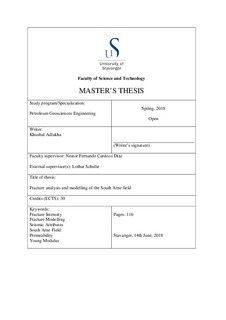| dc.contributor.advisor | Cardozo, Nestor | |
| dc.contributor.advisor | Schulte, Lothar | |
| dc.contributor.author | Adlakha, Khushal | |
| dc.coverage.spatial | North Sea | nb_NO |
| dc.date.accessioned | 2018-09-17T10:55:29Z | |
| dc.date.available | 2018-09-17T10:55:29Z | |
| dc.date.issued | 2018-06-14 | |
| dc.identifier.uri | http://hdl.handle.net/11250/2562932 | |
| dc.description | Master's thesis in Petroleum Geosciences Engineering | nb_NO |
| dc.description.abstract | Fractures are paramount elements in reservoirs, and they are omnipresent in almost all outcrops. The importance of fractures lies in their ability to provide permeable pathways and consequently increase the reservoir permeability. Therefore, fracture characterization and reliable fracture modelling are crucial in hydrocarbon exploration and production. The main objective of this study is to provide a detailed analysis of fractures measured at wells and their relationship to rock properties such as the Young Modulus. This study also focuses on using the seismic Young Modulus, resulting from seismic amplitude-variation-with-offset (AVO) inversion and structural seismic attributes like ant tracking and variance for guiding the modelling of fracture intensity. This approach represents an alternative workflow for improving fracture modelling by reducing the uncertainty in fracture intensity. The fracture models resulting from the different fracture intensity models are upscaled in a 3D grid in order to estimate their corresponding permeability distribution. These alternative permeability models are compared and discussed. The area of study is the South Arne field which is located in the Central Graben in the western part of the Danish North Sea. It consists of an elongated anticline in a fractured chalk reservoir. The results of the rock physics study indicate that the fractures of the South Arne field are associated with clay-poor chalk characterized by high Young Modulus values. The analysis of the well fracture data shows that the WNW-ESE fracture trend dominates the reservoir. General strike directions of the measured fractures are difficult to derive by conventional methods, such as stereo-net analysis because of the large data scattering. Therefore, a new methodology is discussed that allows a more reliable estimation of the fractures strike directions. The permeability models obtained from the fracture intensity guided by the seismically derived Young Modulus and seismic attributes, show zones of high and low permeability that are not observed in the permeability models obtained from interpolation techniques. | nb_NO |
| dc.language.iso | eng | nb_NO |
| dc.publisher | University of Stavanger, Norway | nb_NO |
| dc.relation.ispartofseries | Masteroppgave/UIS-TN-IER/2018; | |
| dc.rights | Navngivelse 4.0 Internasjonal | * |
| dc.rights | Navngivelse 4.0 Internasjonal | * |
| dc.rights.uri | http://creativecommons.org/licenses/by/4.0/deed.no | * |
| dc.subject | petroleumsgeologi | nb_NO |
| dc.subject | Young Modulus | nb_NO |
| dc.subject | South Arne Field | nb_NO |
| dc.subject | fracture modelling | nb_NO |
| dc.subject | permeability | nb_NO |
| dc.subject | seismic attributes | nb_NO |
| dc.subject | fracture intensity | nb_NO |
| dc.subject | petroleum geology | nb_NO |
| dc.title | Fracture analysis and modelling of the South Arne field | nb_NO |
| dc.type | Master thesis | nb_NO |
| dc.description.version | submittedVersion | nb_NO |
| dc.subject.nsi | VDP::Teknologi: 500::Berg‑ og petroleumsfag: 510::Geoteknikk: 513 | nb_NO |

